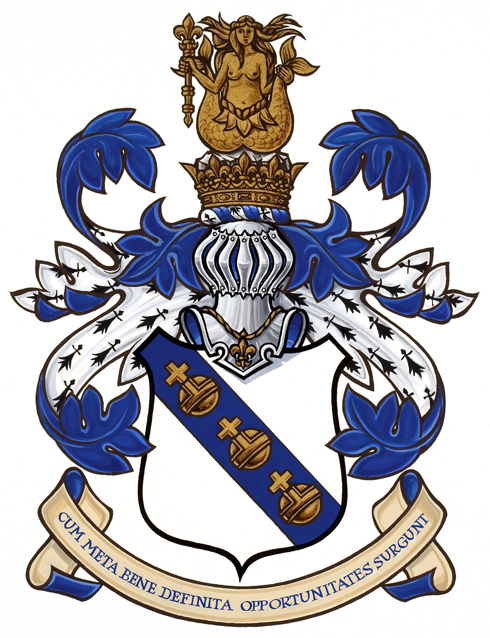- The Governor General of Canada

The contents of this Register are intended for research purposes only. The heraldic emblems found in the Register may not be reproduced in any form or in any media without the written consent of the Canadian Heraldic Authority and/or the recipient.
François Payeur
Gatineau, Quebec
Grant of Arms, Flag and Badge
July 20, 2006
Vol. V, p. 38

[ previous page ]
Blazon
Arms
Argent on a bend Azure three orbs Or;
Crest
Issuant from coronet flory, a melusine Or on a rock proper holding in the dexter hand a sceptre terminating in a fleur-de-lis Or;
Motto
CUM META BENE DEFINITA OPPORTUNITATES SURGUNT;
Symbolism
Arms
Historically, an orb symbolizes temporal power; here, grouped in three, it represents part of the motto of the business founded by François Payeur’s maternal grandfather, Marc-André Rioux Ltée. This is also a historic reference to New France and to Seigneur Jean Riou, the family’s earliest ancestor in Canada. Here, the orbs also refer to the fact that at just 24 years old, François Payeur had already travelled the globe, representing his country or institutions. The colours of the field and band make Mr. Payeur’s shield unique.
Crest
The mythical creature Melusine could lure others to follow her with the sound of her voice. In the same way, persuasive speech is the best weapon for a diplomat and professional such as François Payeur because, as he notes, violence is the speech of the poor of spirit and the defeated. The Melusine also symbolizes the voice and, by extension, art in general, about which Mr. Payeur is passionate. As a marine creature, it also represents Rivière-du-Loup, in which the municipality of Saint-Arsène, Mr. Payeur’s birthplace, is located. The floretty sceptre represents power, and in this case, specifically the power generated by effective communication, the master key to harmony.
Motto
Meaning “When the goal is clear, opportunities abound,” the Latin phrase is inspired by the words of British statesman Benjamin Disraeli (1804-1881): “The secret of success is constancy of purpose.”
